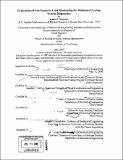Evaluation of Non-Intrusive Load Monitoring for shipboard cycling system diagnostics
Author(s)
Mosman, James P. (James Paul)
DownloadFull printable version (10.07Mb)
Alternative title
Evaluation of NILM for shipboard cycling system diagnostics
Other Contributors
Massachusetts Institute of Technology. Dept. of Mechanical Engineering.
Advisor
Steven B. Leeb.
Terms of use
Metadata
Show full item recordAbstract
The Non-Intrusive Load Monitor (NILM) is a device that utilizes voltage and current measurements to determine the operating schedule of all of the major loads on an electrical service. Additionally, the NILM can use its electrical measurements to diagnose impending failures in the mechanical systems that are actuated by the electric loads. Ongoing NILM research conducted at Massachusetts Institute of Technology's Laboratory for Electromagnetic and Electronic Systems (LEES) is exploring the application of NILM technology in shipboard environments. For the current shipboard applications, diagnostic software development is in progress. To aid in that process, research was done to understand the dynamics of a shipboard cycling system. This thesis presents an in-depth examination of the development of diagnostic indicators for a shipboard vacuum assisted waste disposal system. Measurements and experimentation were conducted onboard USCGC SENECA (WMEC-906), a 270-foot Coast Guard Cutter. In order to better understand the system dynamics, a computer based model was developed to simulate the system. (cont.) The intent of creating an in-depth model was to develop diagnostic methods that are applicable to any shipboard cycling systems. First, a base model is designed followed by the exploration of a realistic model that includes variation commonly found in the system. Thirdly, a diagnostics section explores methods to detect increased pump operation and distinguish between high system usage and the presence of a leak. Lastly, a basic cost analysis is done on the sewage system to show the benefits of installing a NILM.
Description
Thesis (Nav. E. and S.M. in Ocean Systems Management)--Massachusetts Institute of Technology, Dept. of Mechanical Engineering, 2006. Includes bibliographical references (p. 90-91).
Date issued
2006Department
Massachusetts Institute of Technology. Department of Mechanical EngineeringPublisher
Massachusetts Institute of Technology
Keywords
Mechanical Engineering.